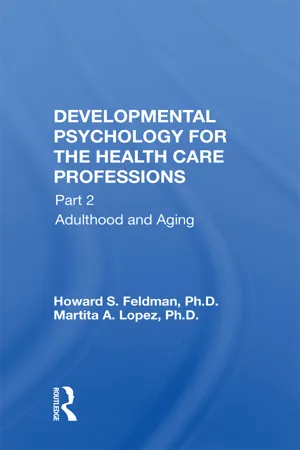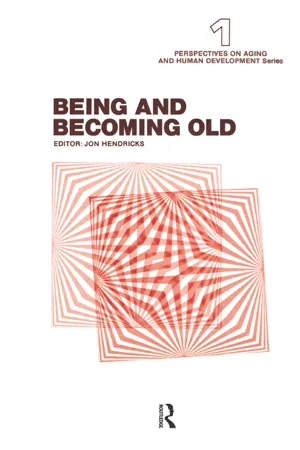Psychology
Social Development in Adulthood
Social development in adulthood refers to the changes and growth in an individual's social relationships, roles, and interactions as they age. This includes forming and maintaining friendships, romantic relationships, and family dynamics, as well as adapting to changing social roles and responsibilities. It also involves the development of emotional intelligence, empathy, and communication skills to navigate complex social environments.
Written by Perlego with AI-assistance
Related key terms
4 Key excerpts on "Social Development in Adulthood"
- eBook - ePub
Developmental Psychology For The Health Care Professions, Part Ii
Young Adult Through Late Aging
- Howard. S. Feldman(Author)
- 2020(Publication Date)
- Routledge(Publisher)
1 A Developmental Perspective on AdulthoodIntroduction
Since the 1960s, there has been growing interest in and research on the adult years of the life cycle. Previously, developmental studies had focused on childhood and adolescence, in which an orderly relationship between age and growth was assumed. Adulthood had been looked at as a time of stability, the end point of earlier developmental processes. The changes presumed to occur during adulthood were typically seen as centering around issues of deterioration that take place gradually, universally, and in an age-related pattern. These assumptions are now being challenged, and the span of time between early adulthood and ultimate death has become an area of great research activity. The new orientation looks at human development as a life-long process with change taking place throughout every phase, and its goal is to identify which changes take place at which points in the life course and to establish the nature of the patterns and interrelationships of these changes. Throughout adulthood, individuals experience growth, stability, stagnation, and deterioration in many aspects of their lives. These processes are subject to an intricate interaction between biological, psychological, and socioenvironmental factors.We will be looking at three periods of adulthood identified on the basis of chronological age: young adulthood, from 18 to 40; middle adulthood, from 40 to 65; and later adulthood, from 65 until death. This division is somewhat arbitrary, although it has heuristic value; issues and events actually overlap these periods and may occur repeatedly throughout adulthood. The first chapter provides a general overview of adult developmental psychology and explores physiological changes in young and middle adulthood. The second and third chapters explore young and middle adulthood, respectively, and examine psychological issues that are dealt with during those periods, as well as the adult's involvement in relationships and work. The next three chapters focus on later adulthood, with the fourth looking at the relationship between health and aging and the fifth examining the research on cognitive changes that take place in later adulthood. The last chapter explores psychosocial processes such as coping, adaptation, retirement, and death in old age. - eBook - ePub
Human Behavior in the Social Environment
Perspectives on Development, the Life Course, and Macro Contexts
- Anissa Taun Rogers(Author)
- 2020(Publication Date)
- Routledge(Publisher)
Social workers can play an instrumental role in the lives of young adults, particularly those experiencing problems with development. For example, according to Erik Erikson, young adulthood is a time when individuals work toward closeness in their relationships. Young adults learn to sacrifice in their relationships without losing a sense of their identity. Some young adults may find that they are unable to relate to others in an intimate way, or they may experience difficulties in maintaining a stable sense of self when involved in close relationships. Social workers might assist clients who experience these types of problems by working with them to build self-identity, healthy boundaries, and relationship skills.As Gudrun’s social worker, you can assist her with relationship issues as you work to help address the symptoms that have resulted in her hospitalization. Particularly if Gudrun is diagnosed with a mental illness, she will likely need extra support in working on relationships with friends, family members, co-workers, employers, and others with whom she has contact. The social worker can also assess Gudrun’s physical, cognitive, and emotional functioning to help minimize any symptoms of mental distress and ensure that these symptoms do not seriously impact her health and well-being.THE INDIVIDUAL IN EARLY ADULTHOOD
Although physical development has slowed down somewhat by early adulthood, many changes still take place in other areas that, although generally positive, can create problems for some young adults. Just a few of the issues that young adults may bring to social workers involve mental illness, disability, and questions around spirituality. But before discussing them, let us look at a relatively new lens through which to view developmental tasks for people in this stage of life.Emerging Adulthood
In recent decades, young people have been engaging in roles associated with adulthood much later than they did in previous generations. This shift led Jeffrey Arnett (2000) to conceptualize a new life stage called emerging adulthood - eBook - ePub
- Jon Hendricks(Author)
- 2019(Publication Date)
- Routledge(Publisher)
et al., 1964;Pressey and Kuhlen, 1957), there is as yet a relatively small body of research, either longitudinal or cross-sectional, specifically designed to study the interrelationship between socializing agents and factors and the psychological aspects of adult development. This in part results from early psychoanalytic influences which tended to view the individual as definitively formed primarily by the circumstances of his infancy and early childhood. It is not accidental that a considerable proportion of the research on adulthood done thus far is based on samples, now adult, originally drawn for studies of early personality development in children. In studying change in these groups in later life, the emphasis is, perforce, on those characteristics selected for the study of childhood, with consequent relative neglect of adult socialization processes (e.g., see Clausen, 1964).In the work of Neugarten (1969, in press), personality changes in adulthood are indeed examined in the light of factors associated with processes of socialization, such as age norms and age constraints. Conversely, disengagement theory (Cumming and Henry, 1961), which postulates a highly compatible change in the individual’s relationship to his society and in his society’s relationship to him with advancing age, is now being examined in the light of self-concept and personality constructs (Henry, 1964, 1965; Havighurst, Neugarten, and Tobin, 1964; Williams and Wirths, 1965; Cumming, 1968). The model proposed in this paper focuses on perceptions of the self and perceptions of reference individuals, groups and norms in relation to goal formulation and change. This model should provide a framework for making at least tentative distinctions between changes attributable to innate or developmental factors and those resulting from social processes and pressures.Finally, this model has also evolved in part from earlier research on studies of normal and abnormal aging.3 This work suggested the importance of conscious reappraisal and often reorientation of goals and of goal-related behavior in order to achieve some degree of equilibrium between the two domains (Clark and Anderson, 1967; Lowenthal, et al., 1967). For the older subjects studied in this research, this reorientation typically took one of three forms: (a) renouncing goals which for reasons of social constraint or physiological limitations were no longer feasible, sometimes substituting practicable goals relating to the same global values or overall intentions; (b) reevaluating or reinterpreting past choices and behavior in such a way that they emerge as compatible with global values; or (c - eBook - ePub
Human Growth and Development Across the Lifespan
Applications for Counselors
- David Capuzzi, Mark D. Stauffer(Authors)
- 2016(Publication Date)
- Wiley(Publisher)
One cannot underestimate the important connection between optimal aging and social relationships. Lansford, Antonucci, and Akiyama (2005) found that women in the United States and Japan have fewer depressive symptoms if they have a spouse, mother, and a best friend in their social network, and Antonucci, Ajrough, and Janevic (2002) noted that men who have less education but large social networks were as physically healthy as highly educated men. Studies also suggest that social relationships help buffer against stress, so it seems imperative that new research focuses on how to promote healthy social relationships in late adulthood in order to promote optimal aging (Ertl, Glymour, & Berkman, 2009).Social Development Theories
It seems rather ironic that although people continue to develop throughout the lifespan, it has been only in recent years that attention has been paid to social development in late adulthood. Given the large cohort of people in this age group, it is critical that we understand more about the ways social relationships evolve and impact older adults. Several theories shed light on this process.Erikson's Ninth Stage
Erik Erikson was a developmental psychologist whose comprehensive theory of development emphasized the importance of social relationships (Meece, 2002). He believed that human beings have similar basic needs, as well as societal and cultural expectations and personal relationships, which influence how people they respond to their basic needs. Although this famous theorist didn't deal exclusively with social development, his theory has significant implications for adults in late adulthood, particularly as it has been reconceptualized.Erik Erikson died in 1994 at age 91 years, and his wife and collaborator Joan died 3 years later, at age 95 years (Gusky, 2012). While Erikson was in a nursing home, he and Joan did a videotaped interview in which Joan spoke about Erikson's last stage of development, integrity versus despair. She noted that this stage should be reconceptualized—that “they owed an apology to people for theorizing that wisdom and integrity were so great” (Gusky, 2012, p. 60). She stated that it is easy to theorize about something, but when you are actually there it is a different matter. Thus, a new stage—the ninth stage—was developed a year after Erikson's death. Joan described this final stage of development as a metaphor of a woven fabric. Titled the woven cycle of life
Learn about this page
Index pages curate the most relevant extracts from our library of academic textbooks. They’ve been created using an in-house natural language model (NLM), each adding context and meaning to key research topics.



